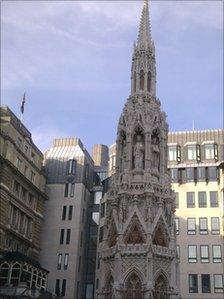Renovated Eleanor's Cross in Charing Cross unveiled
- Published

The original Eleanor's Cross was built by Edward I in the 13th Century
A 145-year-old monument in Charing Cross, which was classed At Risk by the English Heritage, has been unveiled following renovation work.
Eleanor's Cross, located outside the station, is a replica of the 13th Century structure built by Edward I in memory of his wife Eleanor of Castile.
The original was located in what is now Trafalgar Square and marked the point to measure distances to London.
The revamp work on the replica began in October 2009.
The job involved replacing about 100 missing or damaged features, including heraldic shields, an angel, pinnacles, crockets, finials and securing weak masonry.
Funeral resting place
The 13th Century cross was one of 12 built marking resting places along the route of Queen Eleanor's funeral procession from Lincoln to Westminster Abbey.
Queen Eleanor was taken ill and died near Lincoln during her journey to Scotland to meet her husband in 1290.
The original monument was demolished in 1647 at the demand of Parliament.
A plaque at the original site marks it as the point where all mileage distances on road signs to London were measured.
The current structure has been surrounded by scaffolding for about five years for safety reasons. It was built in 1865 and stands metres away from the original's location.
Network Rail carried out the renovation work on the stone structure.
Principal architect Robert Thornton said: "The Eleanor Cross represents part of London's railway history, is a well-established landmark in the West End and something that should be preserved for future generations of residents and visitors."
Timothy Jones, from English Heritage, said the monument was "an invaluable part of the city's personality and interest".
"Although not one of the original crosses created by Edward l for his beloved wife, Eleanor of Castile, this Victorian recreation is a fine example of architect EM Barry's work, and we are delighted to see it so beautifully and carefully restored, and happily, it can now be removed from our Heritage at Risk Register."